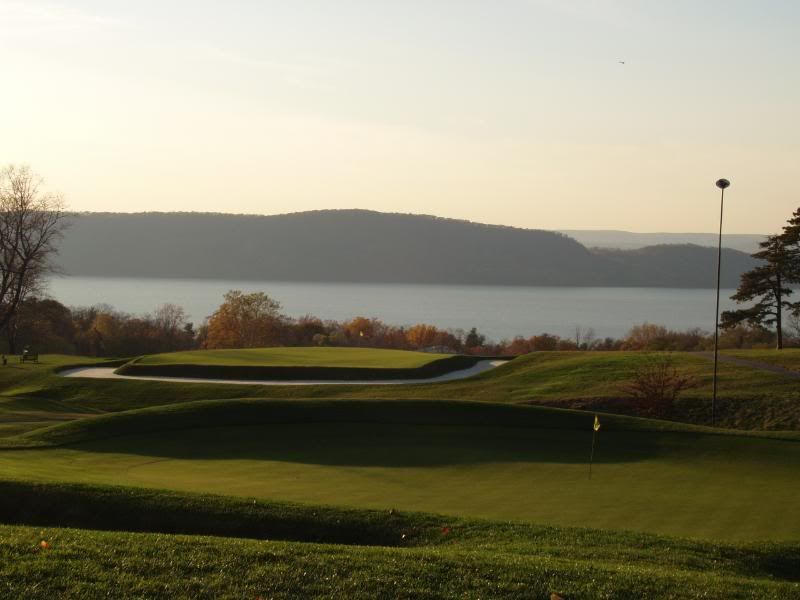
Though the economic downturn has dramatically reduced the number of new courses being constructed and opened in America, many architects are turning to restoration projects to stay busy until funding becomes available for building new designs. Some architects have built their own cottage industry specializing in one designer, becoming experts at recreating that architect’s style, and bringing those courses back to the former glory they enjoyed when they first opened many decades earlier. One well-received restoration can lead to many future jobs from other courses designed by the same Golden Age architect, clubs eager to stiffen their course’s challenge in the face of technological advances, and bring back strategic playing options that had been lost over time, sloppy maintenance practices, tree growth, or over-zealous greens committees.
In particular, the restoration of the designs of Charles Blair Macdonald, his protégé Seth Raynor, and Raynor’s associate Charles “Steamshovel” Banks is one of the most encouraging trends in golf course architecture. Macdonald was the driving force behind the creation of the National Golf Links of America, his magnum opus, and the course which has inspired generation after generation of designers with its masterful strategies, design concepts which have withstood not only the test of time, but countless technological advances. National, as she is known to her fans, was intended by Macdonald to be a touchstone of the greatest holes the golf world had ever seen, and despite being only a fingernail over the 7,000 yard mark, she still stands as the standard by which all great courses are judged. National spawned a bloodline of courses that includes such epic designs such as Fisher’s Island, Piping Rock, Forsgate, Yale, and Shoreacres.
New Jersey’s George Bahto has become a well-respected expert on the designs of Macdonald, Raynor, and Banks, so much so that no less a personage than Mike Keiser, the visionary behind the Bandon Dunes Golf Resort, has tapped him to assist award-winning architect Tom Doak in building Old Macdonald, a new course at the Bandon Dunes facility that evokes Macdonald’s design concepts. Bahto is also the author of the seminal book about Macdonald – The Evangelist of Golf, and is presently working on a new book about Seth Raynor.
Bahto also frequently works architect Gil Hanse, and together the tandem have recently teamed up at Sleepy Hollow Country Club and Essex County Country Club, (in West Orange, New Jersey), with results that are nothing short of astounding. Essex County needed some additional length and bunkering to restore some of the strategies Banks has designed when, in 1928, he remodeled an old A.W. Tillinghast layout that dated back to 1887. Sleepy Hollow needed several holes and greens completely remodeled as well as significant re-bunkering and tree removal. In both cases the work was met with resounding approval.
ESSEX COUNTY COUNTRY CLUB
Essex County’s front nine has one of the most unusual routings in golf – the course opens with five consecutive par-4s, then finishes 3-5-5-3. (Banks kept the greens Tillinghast built on holes one through six and at nine.) Still, the variety among the holes is remarkable. Two greens run severely away from the player – holes three and five – making players carefully consider what kind of shot to hit into the green and what side they should approach from to get close to the pin. At three, a Leven hole, the drive must be threaded between two bunkers which pinch the fairway. On the approach, the greenside bunkers form a crescent shape, wrapping around the green’s right side from the six o’clock to twelve o’clock position and obscure part of the green from the fairway. At the fifth hole, a series of bunkers crosses in front of the green diagonally.
The par-3s may be the course’s greatest strength. The sixth is a Tillinghast version of a Redan. “We deepened the pot bunker in front [of the green] and able superintendent Jason Thompson expanded the green dramatically to the left rear, and actually in nearly all directions. That green is now about twice the size it was when Gil and I started the project,” said Bahto approvingly. The ninth is dramatically uphill and is guarded in front by a cavernous bunker whose floor sits close to twenty feet below green level, definitely one of the hardest holes on the course. The idyllic 11th crosses a gorge, and is regarded as one of Banks’s best Eden holes, while the brutishly long 15th is a Biarritz, though much different than most Macdonald, Raynor, Banks versions of this hole since the trademark “swale” is so slight as to be imperceptible. Since it calls for a draw, and because the downslope cants from right to left, helping the ball filter to back-left hole locations, many players have thought it a Redan hole instead. But its length – over 200 yards – and huge green, set up to accept a driver of fairway wood off the tee, are indicia of a Biarritz instead, even though the trademark swale is almost non-existent.
The back features one spectacular hole after another. The 12th is an amalgam of three different features Banks liked to employ: there is a hog’s back in the fairway, a Road Hole green complex, and a “Maiden” feature for internal green contours – two breast-shaped bumps. The 14th hole is all uphill to a two-level punchbowl green guarded by a gaping Lion’s Mouth bunker. Hanse and bahto added a fantastic Principal’s Nose bunker at the 16th hole about 50 yards short of the Double Plateau green. Finally, 17 is a two-shot reverse Redan that calls for a draw off the tee, then a fade into a green guarded by a bunker sitting twenty feet below fairway level.
Additionally, significant tree removal has resulted in expansive views all across the 180 acre property, as well as healthier turf and greater exposure to the winds that whip across the hilltop. With it’s severely rolling terrain, Essex is once again quickly rising to the top of must-play lists for aficionados of classic architecture.
SLEEPY HOLLOW COUNTRY CLUB
Two of the most headstrong men in America combined and collided to build Sleepy Hollow C.C. overlooking the broad expanse of the Hudson River. In 1911, William Rockefeller hired Macdonald, fresh off his success at National, to build 18 holes. The two quarreled famously and although the course proved successful, A.W. Tilling hast was hired in the late ’20s to build an additional nine holes, many of which became incorporated into what serves as the main course as it exists today. (There is still a shorter nine-hole course on the property as well.) Tillie routed holes through the present-day playing corridors of holes 1, 18, and 8-12.
Cut to the 1990’s and the members of Sleepy Hollow had a conundrum. To restore the course to its former glory, should they preserve the flavor or Macdonald or Tillinghast? Both were giants, with monumental successes in their respective portfolios, and sterling legacies as designers. Golf design history hung in the balance of their decision. Rees Jones was consulted and did a great deal of work on the course, but the result was a modern look and feel that did not promote or preserve the styles of either Mac or Tillie. Enter green committee chairman George Sanossian, who moved decisively, and with the blessing of the club, hired Hanse and Bahto to redesign the entire course in the flavor of Macdonald.
The results were breathtaking. Expansive tree removal opened up miles of dazzling views across the Hudson River, and across the property as well. Bunkers that were flat – two dimensional and lacking in challenge – became yawning chasms that must be avoided at all costs. Finally, great strategies were created in the flavor of Macdonald. As golf architecture expert Ran Morrissett wrote, “The work performed at Sleepy Hollow from the summer of 2006 through the fall of 2007 represents one of the great transformations in the history of golf course architecture. From a lifeless course that had lost its soul, a ‘new old’ one full of character was born.”
First, Bahto and Hanse improved the greenside bunkering. At the second hole – probably the least interesting terrain for a golf hole as it was a dreary slog 350 yards straight up a hill – they added a deep wrap-around bunker about eight-feet below the level of the green. Therefore the wedge approach is markedly more difficult and the penalty for missing the green far more severe. At the 11th, the pushed up green pad again sits well above the floor of the bunkers making for not only one of the hardest approaches on the course, but one of the most difficult recovery shots should the player miss even the slightest bit on the approach. Finally, at the 16, the pair recreated another great wrap-around bunker and now the hole is a quintessential example of a great “Short” hole with its deep hazard and fierce internal contours which admirably defend par even though the hole is not long by any standards.
Next, Hanse and Bahto added strategic fairway bunkers all over the course, most notably and four, six, and 14. At four, a bunker added at the crest of the hill guards the best approach into the green, (the left side). At six, already perhaps the hardest hole on the course with its long carry over a steep hill, they added a Principal’s nose bunker complex which dramatically narrows the landing area for players who lay-up short of the green. The short downhill 14th already featured a tiny diamond-shaped green a paltry seventeen yards across with a severe left-to-right slope. A long cross bunker now confounds players who drive too far, leaving them a downhill lie or a long bunker shot to one of the hardest greens to hit on the course.
Bahto and Hanse also redesigned holes 12 and 13, creating new playing corridors for both holes. The 12th green has been moved 100 yards to the left and is now a small double plateau, appropriate for a per-5 since it is really three small greens in one. At the 13th, they cut a long cross hazard into a ridge line, making placement of the drive difficult in both its length as well as accuracy. Again, deep bunkers flank the green and a miss is penalized brutally.
Finally tree clearing opened expansive vistas across the course. By clearing trees at the fourth hole, we get great views across the 14th as well. Moreover tree clearing at the fifth hole created a majestic skyline green, one of the finest approach shots on the eastern seaboard. Other great holes include a brilliant reverse Redan at seven, and a stunning Punchbowl green at 15.
Hanse and Bahto’s work at Sleepy Hollow was so well received by the members and golf industry alike that the club is moving forward with an entire second phase of the master plan. Thankfully, many courses are following suit in restoring the great design features of Macdonald, Raynor, and Banks and golf design is once again celebrating a Golden Age, where courses are eschewing center-line, penal architecture for the boring banal slog it is, instead opting for the interesting, the cerebral, and the timeless.




